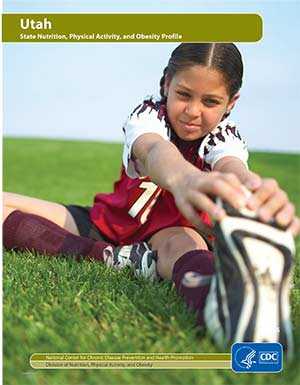Utah State Nutrition, Physical Activity, and Obesity Profile
Many American communities lack environments that could support healthy diets and regular physical activity. Healthy dietary and physical activity practices can lower the risk for heart disease, type 2 diabetes, and some cancers.1,2
In addition, excess calorie intake and physical inactivity contribute to obesity, which is associated with some of the leading preventable chronic diseases, including heart disease, stroke, type 2 diabetes, and some cancers. Among adults, the medical costs associated with obesity are an estimated $147 billion.1,2,3
Public health approaches can help make healthy options available, accessible, and affordable. The Centers for Disease Control and Prevention’s Division of Nutrition, Physical Activity, and Obesity (DNPAO) supports the nation to establish sustainable programs to improve dietary quality, increase physical activity, and reduce obesity and overweight. DNPAO funds and works with state health departments through a cooperative agreement (State Public Health Actions to Prevent and Control Diabetes, Heart Disease, Obesity and Associated Risk Factors and Promote School Health program).
This profile highlights data on dietary quality, physical activity, and obesity in Utah and select activities funded with this cooperative agreement. For more information about CDC’s work to support healthy eating and physical activity, please see the DNPAO website.
Population Statistics
Estimated Population of Utah: 2,995,9194
Adult Statistics
Dietary Behaviors5
- 36.5% of adults reported consuming fruit less than one time daily.
- 20.4% of adults reported consuming vegetables less than one time daily.
Physical Activity5
- 55.3% of adults achieved the equivalent of at least 150 minutes of moderate intensity physical activity per week.
Overweight and Obesity5
- 33.8% of adults were overweight.
- 25.7% of adults had obesity.
Adolescent Statistics
Dietary Behaviors5
- 33.0% of adolescents reported consuming fruit less than one time daily.
- 30.8% of adolescents reported consuming vegetables less than one time daily.
Physical Activity5
- 19.7% of adolescents were physically active at least 60 minutes per day on all 7 days in the past week.
Overweight and Obesity5
- 11.0% of adolescents were overweight.
- 6.4% of adolescents had obesity.
Child Statistics
Breastfeeding5
- 87.9% of infants were ever breastfed.
- 61.6% of infants were breastfed for at least 6 months.
Overweight and Obesity5
- 12.3% of children aged 2 to 4 years in the Special Supplemental Nutrition Program for Women, Infants, and Children (WIC) program were overweight.
- 8.7% of children aged 2 to 4 years in WIC had obesity.
State Activities
Utah worked on the following select activities during the first 2 years of the State Public Health Actions program.
- Worked with Utahans Against Hunger and local health departments (LHDs) to develop the infrastructure for Electronic Benefits Transfer (EBT) at farmers’ markets and identify markets willing to implement EBT. The number of farmers’ markets using EBT increased from 13 in 2013 to 21 by 2014.
- Partnered with all 12 LHDs in Utah to ensure compliance with the Federal Lactation Accommodation Law through implementation of breastfeeding worksite policies. As of 2015, all LHDs have agreed to develop policies.
- Partnered with all 12 LHDs in Utah to complete the CDC Worksite Health ScoreCard and implement polices to improve nutrition and physical activity. As of 2015, 9 of the 12 had completed the scorecard and were working to make improvements.
- Promoted the Targeting Obesity in Preschool and Childcare Settings (TOP Star) program to child care facilities throughout the state of Utah. The TOP Star program aims to help child care providers improve their nutrition and physical activity environments.
Program Highlights
References
- US Department of Health and Human Services. National Institutes of Health. Managing Overweight and Obesity in Adults: Systematic Evidence Review from the Obesity Expert Panel, 2013.
- World Cancer Research Fund / American Institute for Cancer Research. Food, Nutrition, Physical Activity, and the Prevention of Cancer: a Global Perspective. Washington DC: AICR, 2007
- Finkelstein, EA, Trogdon, JG, Cohen, JW, Dietz, W. Annual medical spending attributable to obesity: Payer- and service-specific estimates. Health Affairs. 2009;28(5):w822-w831.
- US Census Bureau. State and County QuickFacts 2015 website. Accessed February 22, 2016.
- Centers for Disease Control and Prevention. Nutrition, Physical Activity and Obesity Data, Trends and Maps website. Accessed February 22, 2016.
- Page last reviewed: November 21, 2016
- Page last updated: November 21, 2016
- Content source:


 ShareCompartir
ShareCompartir
